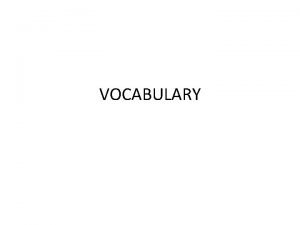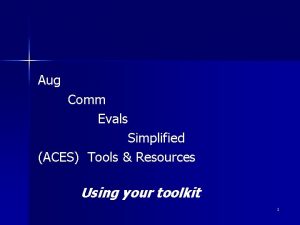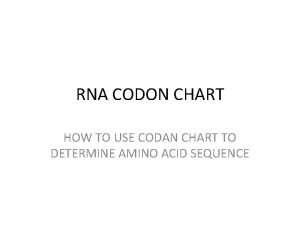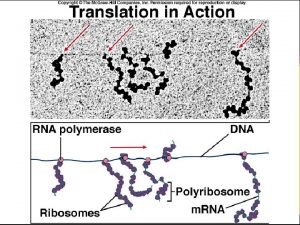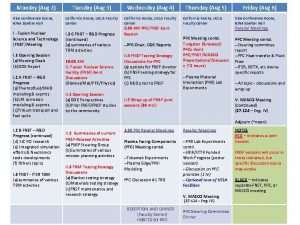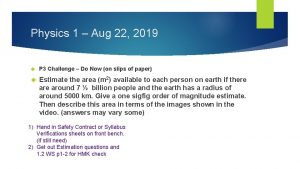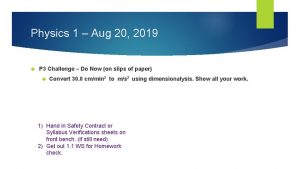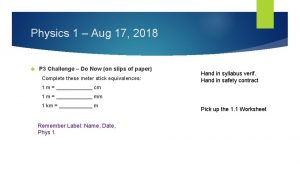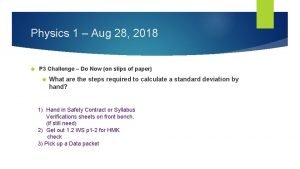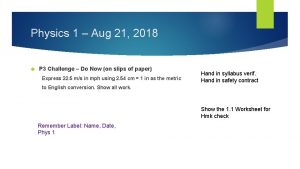Physics 1 Aug 30 2019 P 3 Challenge










- Slides: 10

Physics 1 – Aug 30, 2019 P 3 Challenge – In detail, how does one draw a maximum slope line? Hand in Graphing Lab, Attach Graph Assignment: IB 2. 1 1 D Motion Practice Worksheet p 1 - 2 (1 physical sheet) IB 2. 1 Motion To describe and model 1 D Motion with equations and graphs Agenda for IB 2. 1 Motion Position, Displacement and Distance Average speed, average velocity Instantaneous velocity Acceleration

Motion https: //www. youtube. com/watch? v=WSl 1 c. VCp. BFs Strategy: start as simple as possible Point mass. Relative to some frame of reference. (default: up down etc) Defines the variable: Position Restrain to move in one dimension: the x dimension. (or y or z) The reference position: at the origin, at rest Symbol: x 0. Unit: meter, m. x 0 = 0 m

Position, x; Displacement, s Move to a new position, x. Displacement: If s >0, positive x axis If s< 0, negative x axis. The SIGN of s indicates the DIRECTION of the displacement. Displacement is a vector. Vectors have magnitude and direction. Vectors are modeled with an arrow. Tail at the origin, tip at the current position of the point. sx, sy, and sz are often written simply as x, y and z. Implied vectors. s = (x – x 0). 0 0

Distance, d Distance: length of path traveled, d MAY be equal to Displacement, but not always. Displacement is a vector, distance is a scalar. Displacements may be positive or negative to indicate direction. Distances will always be positive. Distance is your odometer. Ex: An ant, starting at the origin moves 2 m in the negative direction, turns around and moves 3 m in the positive direction. A) What is the displacement of the ant? B) What distance has the ant traveled?

Time, t Convention: Clock starts when motion starts. Symbol: t to = 0 sec Unit: seconds (little o means “initial” or time = zero) Some later time is t Elapsed time is ∆t = t-to Often, simply t is used for simplicity to represent the length of time from the start of the clock to the current moment.

Average Speed/Average Velocity

Instantaneous Velocity and Average Acceleration

About Acceleration is a vector. A positive acceleration (in the + direction) is the result of An object moving in the + direction, speeding up. OR an object moving in the – direction slowing down. A negative acceleration ( in the – direction) is the result of An object moving in the + direction, slowing down. OR an object moving in the – direction, speeding up. A larger acceleration is a large change in velocity of a given t. A larger acceleration is the same change in velocity over a shorter time.

Sample Problems A wide receiver running in the positive direction toward his own goal line at 3. 5 m/s slows to 0. 5 m/s still toward his own goal line in order to catch the ball 6 seconds later. What was the average acceleration for the player? A car moving at 16 m/s drives up to a yellow light and speeds to 18 m/s over 3 seconds to get through the intersection. What is the car’s acceleration over this interval?

Exit Slip - Assignment Exit Slip – Distinguish between velocity and speed. What’s Due? (Pending assignments to complete. ) IB 2. 1 1 D Motion Practice Worksheet p 1 - 2 (1 physical sheet) What’s Next? (How to prepare for the next day) Study IB 2. 1 (1 D) p 35 -37
